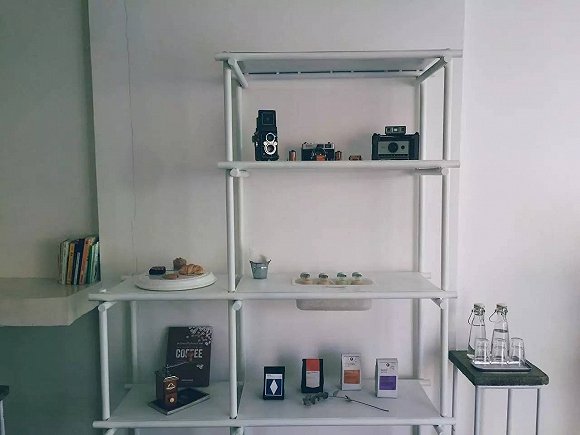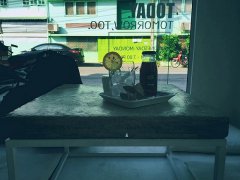Matari Mocha Coffee Region Variety Distribution Flavor Description Features Estate Information

For professional baristas, please follow the coffee workshop (Wechat official account cafe_style)
The following is the information on Matalog:
Country: Yemen
Production area: Bani Mattar district west of the capital Sana'a
Variety: mattari harvest time: 2005, May 2006 arrival
Raw bean treatment: natural sun stone shelling and polishing
Grade: N0.9 batch: LOT-112
Appearance and disadvantages: green belt yellowish 1d/350g
[cup test baking] Bean, cinnamon roast, baking time 10 minutes, close to Agtron/SCAA baking color card N0.65 (Roast color classification system)
Dry aromas: nutty, greasy, creamy, slightly floral, Mideast jujube and spice, citrus and caramel sweet
Wet aroma: citric acid, Belgian caramel biscuit, blueberry acid and red wine, sweet, spice sweet, caramel sweet
Sipping: sour fruit flavor, red wine flavor, sticky oil with sweetness, changeable red wine flavor, a little peppermint cool, sweet aftertaste and nutty chocolate, fine acidity--
Everyone's taste is not necessarily what they like.
You can consider buying a small amount and trying different baking degrees.
Soy beans in an explosion
Drop the beans at the end of the explosion.
Drop the beans from the end of the first explosion to the second explosion.
Touch the beans under the second explosion.
Put the beans into the second explosion for 10-15 seconds
The second explosion of dense beans
I hope you bakers can find a more favorite flavor.
[extended reading]
After carefully savoring this batch of Matali, it immediately reminds people of the book "the Gate of the Arab South" written by Freyas Tucker!
Freya. Freya Stark, a British traveler, was born in Paris in 1893. Freya should be regarded as the greatest female traveler of the 20th century. For example, she heard from her Arab friends that in Iran, deep in the mountains of the Elbourz Mountains south of the Caspian Sea, there are still fortresses and followers of the old assassins. Believers of this sect will take an anesthetic Hasisins. The elders of this sect often use violent assassinations to deal with the enemy. The word Hassins later became the origin of the English word "assassin" (assassin); Freya finally found the remains of this ancient sect and wrote a great book, the Valley of assassins, Valleys of the Assassins, to establish her immortal status as an adventure writer!
Read Freya. When Stark wrote the Gate of the Arab South, it was a pleasure to have a Yemeni Matali mocha.
During the cup test, it was found that this batch of mascara is not only spice, red wine is sour, there is also a light frankincense mixed with citrus and spice complex flavor, quite special, frankincense is produced by olive frankincense wood (Boswellia thurifera) containing volatile oil flavor resin, the collection method is in the bark incision, milky juice, she will harden after contact with the air, into translucent lipids, the Arab world is still cremated It is used in religious ceremonies and as a perfume (raw material for making incense and essential oils). The ancient distribution center of frankincense was Yemen.
In November 1934, Freya sailed through the Red Sea and landed at the Yemeni port of Aden, which was still under British control. from here, Freya embarked on her most unforgettable journey into South Arabia alone. Visit the frankincense road in the Hadaramao Valley, the richest region in the Arab world, hoping to be the first Westerner to find the obliterated capital of the ancient kingdom [Shabawa]. Because Shabawa was the center of the spice trade in ancient times.
Freya's works are not only stimulating and adventurous, but also knowledgeable and well-quoted, with an in-depth description of the historical background, customs and customs of the place to be visited. The Arab Gate of the South was published in 1936. It was a bestseller at that time, and the introduction in the book was "the Road of spices". It really has a lot to do with Yemen.
Yemen Yemen
As long as Yemeni coffee is immediately reminiscent of thick and wild sun-dried beans, Yemeni coffee farmers have been planting according to the ancient methods handed down by their ancestors, because Yemen's rugged terrain is not easy to grow and there is little rainfall. Therefore, Yemeni coffee farmers choose terraces or lowlands for planting, and choose areas that are not easily exposed to strong sun exposure, while most Yemeni farmers are poor and cannot use pesticides. Almost all of them are cultivated naturally and organically.
Yemen Mocha Magdali Yemen Mocca Matari
■ countries: Yemen
■ producing area: Bani Matar
■ altitude: 2000-2400 m
■ treatment: insolation
■ Variety: Madali
■ flavor description: full and thick, woody, wine, juice, berries, dried fruit, dried longan and tobacco, smoky finish
Madali is the best-known coffee bean in Yemen. It is located in the Bani Matari, west of the capital Sana'a. It has a strong, thick flavor with a distinct berry flavor.
Figure-Hami Yemeni Moka Hami Yemen Mocca Haimi
■ countries: Yemen
■ producing area: Al-Haimah
■ altitude: 1500-2200 m
■ treatment: insolation
■ variety: Hami
■ flavor description: Wood, fresh pods and other plant flavors, with chocolate and cream flavor, quite clean
Yemen is a traditional Muslim country. Yemen, located in the Arabian Peninsula, is known as the lady of coffee after coffee, compared with many producing areas in Ethiopia.
Matali's output is small and exquisite. Mattari Matali Mocha produced in the Bani Mattar area
With the clear texture of red wine and deep and charming dark chocolate flavor, this batch of superb Matali mochas produced more tropical fruits in 2012 than in previous years.
Dried fruit flavor, not only increases the depth of the level, is a rare super-level sun-cured coffee beans. The front segment has a wet aroma similar to the smell of dried pineapple and red wine.
It is accompanied by a sweet red wine in the middle and a very strong dark chocolate flavor at the end.
Soft with strong acidity, derived from a continuous fragrant aftertaste, endless aftertaste.
Around the rich personality of the sour taste and aroma full of wild feeling, the aftertaste is full of fantasy wild aroma layer by layer stack …
Although Ethiopia is the birthplace of coffee, Yemen is the first Arab country to start growing coffee.
Today, Yemen still grows coffee in the traditional way, which is not much different from the way it was used in 1600 AD.
Coffee is grown at 3000 meters above sea level, and the diversion irrigation system built 400 years ago is still in use.
The irrigation system collects Rain Water and distributes a limited amount of water equally.
Due to the limited source of water, all coffee is treated by the sun.
The name Mocha comes from the fact that early coffee was mainly exported from the port of Mocha in Yemen.
Although the port was closed in 1800, the name mocha, used for coffee, continues to be used.
There are two main famous kinds of coffee: Mattari and Sanani.
Mattari coffee is full-bodied and has a cocoa flavor
Sanani's coffee is wild and sour.
From one of the oldest coffee producing areas, the Yemeni Matali Mocha Coffee feels enigmatic and mysterious.
Spicy, slightly alcoholic features bring a very exotic taste.
The entrance is smooth, sweet and bitter, and you can taste a strong chocolate taste. Very distinctive and rich flavor of coffee, it is worth trying.
Yemeni coffee is grown on dry sand, but it is a place where it will rain in the rainy season. The root of the coffee tree is rich in running water.
But gave birth to the Yemeni mocha that cannot be replaced by the coffee world.
Matali coffee particles are small and slender, uniform color represents the best quality. With unique and rich flavors of red wine, dried fruit,
Grapes, cinnamon, tobacco, and the most well-known flavor of chocolate. Coffee beans have jasmine aromas after grinding, and fermented wine can be smelled at high temperatures after cooking.
Spat tasting has a little change of grape acid in the mouth, Shengjin is sweet and round with the sweetness of cocoa chocolate, and begins to taste the changeable and complex taste when the temperature drops.
The bottom of the cup is very charming with malt sweetness, the overall style is gentle and introverted, and the aroma and finish are mellow with mocha, which is really after coffee.
Origin: Yemen Yemen
Producing area: Bani Matar Bani Mata
Height: about 1700 m
Treatment: sun drying
Variety: Yemeni native species Heirloom Yemen Mocha Seedstock
Baking method: Cinnamon Roast shallow baking
Properties:
1. Palate: red wine, dried fruit, grape, cinnamon, tobacco, chocolate.
two。 Aroma: sweet taste of jasmine and malt.
3. Vision: the bean shape is small and slender.
Yemen, by the Red Sea, is the ancestor of the earliest coffee exported in the coffee-producing country, and the port of Mocha is its earliest port of export, and the early coffee planting in Yemen 500 years ago also surrounded the hills around the harbor. There are many names of the port of Mocha, including: Al-Makha, Al-Mocha, Al-Mokka, Mocha. Wait, this mysterious drink was discovered by Portuguese sailors who arrived at the port of Mocha in the 17th century, and since then coffee has been introduced into Europe.
The current export port of Yemeni coffee is Port of Aden (Aden) or Port of Holiday (Hodeida). Yemeni coffee is still grown in the same way as it was 500 years ago, with a wide variety of varieties, including adzuki bean Ismaili and ancient heirloom, as well as Adeni and Mattari.
Yemeni coffee is almost planted on mountain slopes with an elevation of up to 3000Mel 7000ft, belonging to terraced alpine terraces. Because of low rainfall, coffee trees absorb water in a way similar to French grapevines, with strong vitality. They often have to rely on the strong water retention capacity of tree species to survive the dry period, while the dry and high temperature of air and soil also make the fruit look small and hard!
Yemeni coffee is used in the natural sun. Coffee fruits are harvested and spread directly on the courtyard or roof to dry, but some coffee fruits are even directly air-dried on trees and then harvested (this method is called floating). After drying and shelling, stone mills are still used today, which are still dragged by animals, such as camels or donkeys, and camels have been an important animal husbandry industry in Yemen since ancient times.
There are two kinds of coffee raw bean packaging after harvest and treatment. the general grade is packed in linen bags, and the top raw beans (such as Matali) will use traditional straw bags, which are called Mats, which will be woven into a large bag to hold raw beans, and the exquisite ones will be subdivided into 6 small bags, each packed with local cotton cloth, 10 kg each, and then put these 6 small bags into Mats, and then put them into sacks for export. So there are three layers of packing.
Important Notice :
前街咖啡 FrontStreet Coffee has moved to new addredd:
FrontStreet Coffee Address: 315,Donghua East Road,GuangZhou
Tel:020 38364473
- Prev

How to describe the flavor of Maraka Dula coffee beans in Nicaragua the distribution of manors in producing areas
For the exchange of professional baristas, please follow the coffee workshop (Wechat official account cafe_style) Monte Cristo Falls Malakaduri Manor Falls Block Micro-batch Maracadura varieties sunburn Finca Cerro de Jesus Plot La Cascada Microlot Maragaturra Natural ■ country: Niagara ■ production area: Harapa ■ altitude: 1100-14
- Next

Description of characteristic Flavor, planting History and Flavor of single Bean of Matta Mocha Coffee in Yemen
Professional baristas please follow the coffee workshop (Wechat official account cafe_style) Yemen is a traditional Muslim country, located in the Arabian Peninsula, Yemen is known as the lady of coffee, compared with many producing areas in Ethiopia, the output of Matali is small and exquisite. The Mattari Matali Mocha produced in the Bani Mattar area has a clear red color.
Related
- Detailed explanation of Jadeite planting Land in Panamanian Jadeite Manor introduction to the grading system of Jadeite competitive bidding, Red bid, Green bid and Rose Summer
- Story of Coffee planting in Brenka region of Costa Rica Stonehenge Manor anaerobic heavy honey treatment of flavor mouth
- What's on the barrel of Blue Mountain Coffee beans?
- Can American coffee also pull flowers? How to use hot American style to pull out a good-looking pattern?
- Can you make a cold extract with coffee beans? What is the right proportion for cold-extracted coffee formula?
- Indonesian PWN Gold Mandrine Coffee Origin Features Flavor How to Chong? Mandolin coffee is American.
- A brief introduction to the flavor characteristics of Brazilian yellow bourbon coffee beans
- What is the effect of different water quality on the flavor of cold-extracted coffee? What kind of water is best for brewing coffee?
- Why do you think of Rose Summer whenever you mention Panamanian coffee?
- Introduction to the characteristics of authentic blue mountain coffee bean producing areas? What is the CIB Coffee Authority in Jamaica?

